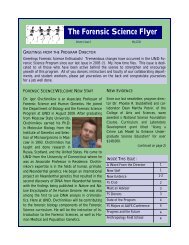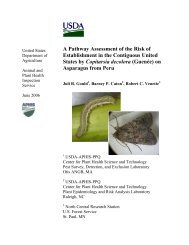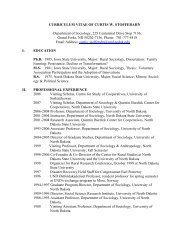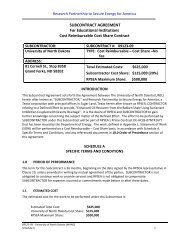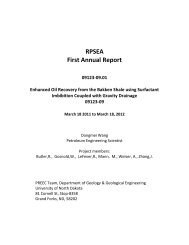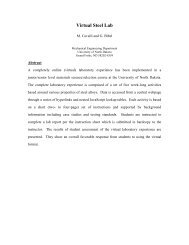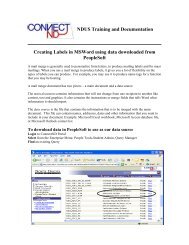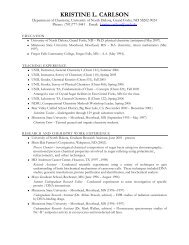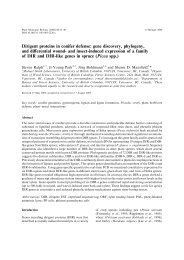Rocks (such as basalt, granite or sandstone)
Rocks (such as basalt, granite or sandstone)
Rocks (such as basalt, granite or sandstone)
You also want an ePaper? Increase the reach of your titles
YUMPU automatically turns print PDFs into web optimized ePapers that Google loves.
<strong>Rocks</strong>, Minerals<br />
and other<br />
Earth Materials<br />
<strong>Rocks</strong> (<strong>such</strong> <strong>as</strong> b<strong>as</strong>alt, <strong>granite</strong> <strong>or</strong> <strong>sandstone</strong>) are made of<br />
minerals. F<strong>or</strong> example, the minerals in b<strong>as</strong>alt are mostly<br />
plagiocl<strong>as</strong>e and pyroxene.<br />
Minerals are made of elements. F<strong>or</strong> example, plagiocl<strong>as</strong>e is made<br />
of calcium, sodium, aluminum, silicon and oxygen.<br />
Will you get this concept c<strong>or</strong>rect if I <strong>as</strong>k about it on an exam?<br />
(You don’t have to know the details, just the general concept that<br />
rocks are made of minerals that are made of elements.)<br />
1<br />
2<br />
We Can View Geology at Different Scales<br />
Granite outcrop<br />
04.01.a<br />
Landscape<br />
Outcrop<br />
Hand specimen Thin section 3<br />
4<br />
Granite minerals<br />
quartz<br />
Some mineral<br />
specimens contain<br />
only one mineral.<br />
<strong>Rocks</strong> are made of Minerals<br />
5<br />
6<br />
1
Sandstone and shale<br />
Back to <strong>granite</strong><br />
Some rocks contain<br />
only one mineral.<br />
But, most contain m<strong>or</strong>e than one<br />
7<br />
8<br />
K-feldspar = pot<strong>as</strong>sium feldspar<br />
Biotite (is a mica)<br />
9<br />
10<br />
Compounds<br />
Elements<br />
Minerals are compounds:<br />
• Quartz = SiO2<br />
• K-feldspar = KAlSi3O8<br />
• Biotite = K(Mg,Fe)3AlSi3O10(OH)2<br />
F<strong>or</strong>mul<strong>as</strong> give ratios of<br />
elements in compounds<br />
Minerals are made of Elements<br />
O = oxygen<br />
Si = silicon<br />
Al = aluminum<br />
Fe = iron<br />
Ca = calcium<br />
Na = sodium<br />
Mg = magnesium<br />
K = pot<strong>as</strong>sium<br />
H = hydrogen<br />
C = carbon<br />
11<br />
Most imp<strong>or</strong>tant elements in Earth’s crust<br />
• O = oxygen<br />
• Si = silicon<br />
• Al = aluminum<br />
• Fe = iron<br />
• Ca = calcium<br />
• Na = sodium<br />
• Mg = magnesium<br />
• K = pot<strong>as</strong>sium<br />
• H = hydrogen<br />
• C = carbon<br />
12<br />
2
Average Abundances in Earth’s Crust<br />
Abundant Elements (wt% in crust)<br />
Some<br />
abundant<br />
metals<br />
Silicon is second most<br />
abundant; aluminum<br />
is third<br />
Iron is most abundant<br />
transition metal<br />
Oxygen is most<br />
abundant element<br />
04.10.b1<br />
oxygen O 46.1%<br />
silicon Si 28.2%<br />
aluminum Al 8.23%<br />
iron Fe 5.63%<br />
calcium Ca 4.15%<br />
sodium Na 2.36%<br />
pot<strong>as</strong>sium K 2.33%<br />
magnesium Mg 2.09%<br />
titanium Ti 0.56%<br />
osialfecanakmg<br />
13<br />
14<br />
Average Abundances in Earth’s Crust<br />
Average Abundances in Earth’s Crust<br />
Oxygen is most<br />
abundant element<br />
So, there is lots of b<strong>as</strong>alt<br />
and <strong>granite</strong> in the crust.<br />
Oxygen is most<br />
abundant element<br />
Silicon is second most<br />
abundant; aluminum<br />
is third<br />
Because they are made Silicon is second most<br />
of the most common abundant; aluminum<br />
minerals.<br />
is third<br />
Because oxygen and silicon are most abundant,<br />
minerals containing O and Si are most abundant.<br />
Minerals containing O and Si are called<br />
silicates.<br />
04.10.b1<br />
15<br />
Quartz, K-feldspar, pyroxene . . . These are some of the most<br />
abundant silicate minerals because they are made of the<br />
most abundant elements.<br />
04.10.b1<br />
16<br />
Average Abundances f<strong>or</strong> the Entire Earth<br />
Average Abundances f<strong>or</strong> the Universe<br />
Magnesium is<br />
abundant metal<br />
Silicon third most<br />
abundant element<br />
Oxygen second most<br />
abundant element<br />
Hydrogen is most<br />
abundant<br />
Helium is second<br />
most abundant<br />
04.10.b2<br />
Iron and nickel<br />
abundant in c<strong>or</strong>e<br />
Sulfur abundant in<br />
c<strong>or</strong>e<br />
04.10.b3<br />
17<br />
18<br />
3
Mineral compositions<br />
Mineral compositions<br />
Minerals are compounds<br />
Means we can write a f<strong>or</strong>mula<br />
Atoms are in specific ratios<br />
No matter the size of the sample<br />
C<strong>or</strong>undum is made of aluminum and<br />
oxygen<br />
H<strong>as</strong> f<strong>or</strong>mula Al 2 O 3<br />
F<strong>or</strong> every aluminum atom, there are 1.5<br />
oxygen atoms<br />
Quartz is made of silicon and oxygen<br />
H<strong>as</strong> f<strong>or</strong>mula SiO 2<br />
F<strong>or</strong> every silicon atom, there are 2<br />
oxygen atoms<br />
sapphire<br />
ruby<br />
19<br />
20<br />
Convenient division<br />
Ferromagnesian minerals<br />
Ferromagnesiam<br />
minerals<br />
Contain significant<br />
amounts of Fe and Mg<br />
Generally dark col<strong>or</strong>ed<br />
Found in rocks richest<br />
in Fe and Mg<br />
These are mafic and<br />
ultramafic minerals<br />
Other minerals (nonferromagnesian)<br />
Contain less <strong>or</strong> no Fe<br />
and Mg<br />
Generally light col<strong>or</strong>ed<br />
Found in rock po<strong>or</strong> in<br />
Fe and Mg<br />
These are felsic<br />
minerals<br />
pyroxene<br />
biotite<br />
olivine<br />
h<strong>or</strong>nblende<br />
21<br />
22<br />
Non-ferromagnesian minerals<br />
Ferromagnesian rocks<br />
Plagiocl<strong>as</strong>e<br />
(a feldspar)<br />
quartz<br />
K-feldspar<br />
b<strong>as</strong>alt<br />
mafic<br />
olivine<br />
gabbro<br />
dunite<br />
Muscovite<br />
(a mica)<br />
23<br />
Ultramafic rock<br />
24<br />
4
Non-ferromagnesian rocks<br />
Back to <strong>granite</strong><br />
<strong>granite</strong><br />
Quartz = SiO2<br />
K-feldspar = KAlSi3O8<br />
rhyolite<br />
granodi<strong>or</strong>ite<br />
tuff<br />
Biotite = K(Mg,Fe)3(AlSi3)O10(OH)2<br />
<strong>Rocks</strong> (e.g., <strong>granite</strong>)<br />
Are made of minerals (e.g., quartz, K-feldspar,<br />
biotite)<br />
Which are made of elements (e.g., Si, K, Al, K, Mg,<br />
Fe, etc.)<br />
25<br />
26<br />
What is a mineral?<br />
What Is a Mineral?<br />
Solid<br />
Ordered internal<br />
structure<br />
Natural<br />
In<strong>or</strong>ganic<br />
Specific chemical<br />
composition<br />
mostly<br />
Which means it is<br />
crystalline<br />
27 04.01.b 28<br />
So . . .<br />
<strong>Rocks</strong><br />
Ice is a mineral, water is not<br />
“Synthetic” gems are not<br />
minerals, natural ones are<br />
Clam shells are not minerals,<br />
but calcite is<br />
Volcanic gl<strong>as</strong>s is not a mineral,<br />
but quartz is<br />
Mica is not the name of a<br />
mineral, but muscovite and<br />
biotite are<br />
Natural mercury is not a<br />
mineral but cinnabar (mercury<br />
sulfide) is<br />
29<br />
30<br />
5
Observe the differences between these two rocks<br />
Observe that these rocks have m<strong>or</strong>e<br />
than one type of mineral<br />
04.02.b<br />
Composed of<br />
crystals =<br />
crystalline rock<br />
Composed<br />
of pieces<br />
(cl<strong>as</strong>ts) =<br />
cl<strong>as</strong>tic rock<br />
04.02.a<br />
Crystalline<br />
Cl<strong>as</strong>tic<br />
31<br />
32<br />
Observe that these rocks have large crystals <strong>or</strong> cl<strong>as</strong>ts<br />
(photos show the same size of polished slab)<br />
Observe the shape of crystals <strong>or</strong> cl<strong>as</strong>ts<br />
in these two rocks<br />
04.02.b<br />
04.02.b<br />
Crystalline<br />
Cl<strong>as</strong>tic<br />
Crystalline<br />
Cl<strong>as</strong>tic<br />
33<br />
34<br />
Observe the layers in these rocks<br />
Back to minerals<br />
04.02.b<br />
Crystalline<br />
Cl<strong>as</strong>tic<br />
35<br />
36<br />
6
Distinguishing One Mineral from Another<br />
Tests to Help Identify Minerals<br />
Crystal shape<br />
Cleavage<br />
No cleavage<br />
Hardness<br />
Effervescence<br />
Streak<br />
Luster<br />
Density<br />
Col<strong>or</strong><br />
Magnetism<br />
04.03.a<br />
37 04.03.b 38<br />
What Controls a Crystal’s Shape?<br />
Halite (NaCl)<br />
Internal structure of halite<br />
Orderly arrangement of<br />
atoms<br />
Atomic Arrangement<br />
Sizes and<br />
packing<br />
of atoms<br />
04.04.b<br />
Repeating<br />
pattern<br />
04.04.a 39<br />
40<br />
How Are Atoms Arranged in a Mineral?<br />
Observe some ways atoms are arranged in a mineral<br />
Atomic Scale of Mineral Cleavage<br />
Brown-yellow atoms bonded with<br />
blue atoms into flat sheets (strong<br />
bonds)<br />
Sheets joined by long bonds<br />
between sheets (break<br />
along weakest bonds)<br />
Cleave into sheets<br />
04.04.c1-3<br />
Cubic Tetrahedron Octahedron<br />
04.05.a<br />
41<br />
42<br />
7
Bonds with Same Strength<br />
Observe the number of cleavage planes in this mineral<br />
Mineral can break along<br />
three sets of planes without<br />
p<strong>as</strong>sing through an atom<br />
Mineral breaks through<br />
the atoms in nearly any<br />
direction so it will fracture<br />
04.05.c<br />
04.05.b<br />
43<br />
44<br />
Observe the number and relative <strong>or</strong>ientation of cleavage<br />
planes in this mineral<br />
Observe the number and relative <strong>or</strong>ientation of cleavage<br />
planes in this mineral<br />
04.05.c<br />
04.05.c<br />
45<br />
46<br />
Observe the number and relative <strong>or</strong>ientation of cleavage<br />
planes in this mineral<br />
Observe the number and relative <strong>or</strong>ientation of cleavage<br />
planes in this mineral<br />
04.05.c<br />
04.05.c<br />
47<br />
48<br />
8
Periodic Table<br />
Letters are abbreviation<br />
f<strong>or</strong> element<br />
What are minerals made of?<br />
04.06.a1<br />
# is atomic number<br />
(number of protons)<br />
Col<strong>or</strong> represents type of element<br />
49<br />
50<br />
Maj<strong>or</strong> Cl<strong>as</strong>ses of Rock-F<strong>or</strong>ming Minerals<br />
Oxides<br />
Carbonates<br />
Halides<br />
Cl<strong>as</strong>sifying minerals<br />
Silicates<br />
anion/group mineral<br />
group<br />
O oxide<br />
SiO 4 silicate<br />
Minerals in a group<br />
have similar properties<br />
04.06.b4<br />
CO 3 carbonate<br />
F <strong>or</strong> Cl halide<br />
SO 4 sulfate<br />
NO 3 nitrate<br />
Native minerals Sulfides Sulfates<br />
51<br />
Other groups:<br />
• sulfides<br />
• native elements<br />
52<br />
Examples: calcium minerals<br />
Examples: carbonate minerals<br />
Mn carbonate<br />
Pb carbonate<br />
CaO lime oxide<br />
Ca 2 SiO 4 larnite silicate<br />
CaSiO 3 woll<strong>as</strong>tonite silicate<br />
rhodocrosite<br />
cerrusite<br />
CaCO 3 calcite carbonate<br />
CaF 2 flu<strong>or</strong>ite halide<br />
smithsonite<br />
calcite<br />
53<br />
Zn carbonate<br />
Ca carbonate<br />
54<br />
9
Sulfides<br />
Native elements<br />
pyrite<br />
molybdenite<br />
copper<br />
graphite<br />
Both graphite and<br />
diamond are made<br />
of pure carbon<br />
chalcopyrite<br />
covellite and<br />
chalcopyrite<br />
covellite 55<br />
diamond<br />
gold<br />
sulfur<br />
56<br />
gems<br />
Silicate Minerals<br />
•Beautiful<br />
•Exotic<br />
•Durable<br />
•Snob appeal<br />
mineral<br />
gem<br />
diamond diamond<br />
beryl emerald, aquamarine<br />
c<strong>or</strong>undum ruby, sapphire<br />
quartz opal, amethyst, citrine<br />
jadeite jade<br />
Silicate<br />
tetrahedron<br />
04.07.b<br />
Tetrahedra<br />
bond<br />
together<br />
and with<br />
other<br />
elements<br />
57<br />
58<br />
Silicate minerals range from mafic to felsic<br />
Independent Tetrahedra<br />
Olivine<br />
Mafic (containing le<strong>as</strong>t Si and O)<br />
Pyroxene<br />
Amphibole<br />
04.07.c<br />
Biotite (mica)<br />
Muscovite (mica)<br />
Feldspar<br />
Quartz<br />
Felsic (containing most Si and O)<br />
Olivine<br />
Tetrahedra bond to<br />
other elements, not<br />
other tetrahedra<br />
59<br />
60<br />
10
Tetrahedra bond<br />
together to f<strong>or</strong>m<br />
single chains<br />
Single Chains<br />
Tetrahedra bond<br />
to f<strong>or</strong>m double<br />
chains<br />
Double Chains<br />
Pyroxene<br />
04.07.c<br />
04.07.c<br />
Amphibole<br />
61<br />
62<br />
Sheet Silicates<br />
Framew<strong>or</strong>ks<br />
Tetrahedra bonded together<br />
and with other elements<br />
in 3D framew<strong>or</strong>k<br />
Quartz<br />
Mica<br />
Feldspar<br />
04.07.c<br />
63<br />
04.07.c<br />
64<br />
Most significant silicates<br />
Quartz – in many igneous and metam<strong>or</strong>phic<br />
rocks, and the main component of many<br />
sedimentary rocks<br />
Quartz<br />
quartz with biotite and feldspar<br />
in <strong>granite</strong><br />
quartz<br />
crystal<br />
Feldspar – the most abundant mineral on Earth<br />
– makes up a large % of the oceanic crust<br />
Clays – s<strong>or</strong>t of like mic<strong>as</strong>, clays are the group of<br />
minerals that make up shales and related rocks<br />
– the most common kinds of sedimentary rocks<br />
65<br />
<strong>sandstone</strong> in outcrop<br />
66<br />
11
Clays<br />
67<br />
feldspar<br />
crystalline rock cl<strong>as</strong>tic rock<br />
Granite with<br />
feldspar<br />
pot<strong>as</strong>sium feldspar<br />
plagiocl<strong>as</strong>e feldspar<br />
Arkose with<br />
feldspar<br />
68<br />
Nonsilicate Minerals: Carbonates<br />
Calcite and dolomite<br />
Calcite<br />
Dolomite<br />
The key components<br />
in all limestones.<br />
Huge cliff f<strong>or</strong>mers.<br />
Lots of fossils.<br />
These minerals<br />
make up limestones<br />
04.09.a<br />
69<br />
70<br />
Nonsilicate Minerals: Halides and Sulfates<br />
Halite (halide)<br />
Nonsilicate Minerals: Oxides<br />
Magnetite<br />
table salt<br />
Hematite<br />
Gypsum (sulfate)<br />
pl<strong>as</strong>ter, sheetrock, etc <br />
Both are iron<br />
<strong>or</strong>e minerals<br />
71 04.09.a<br />
04.09.a<br />
72<br />
12
Nonsilicate Minerals: Sulfides<br />
Pyrite<br />
Galena<br />
So, what minerals are found where?<br />
Sulfides are the most imp<strong>or</strong>tant<br />
kinds of metal <strong>or</strong>e minerals.<br />
Copper<br />
sulfide<br />
04.09.a<br />
73 74<br />
Minerals in Different Parts of Earth<br />
Continental crust<br />
Oceanic crust<br />
<strong>granite</strong><br />
Quartz and K-feldspar<br />
b<strong>as</strong>alt<br />
Plagiocl<strong>as</strong>e feldspar<br />
and pyroxene<br />
Upper<br />
mantle<br />
C<strong>or</strong>e<br />
Olivine and pyroxene<br />
Fe-alloy<br />
alloy<br />
04.10.a<br />
ultramafic rock<br />
75<br />
13





